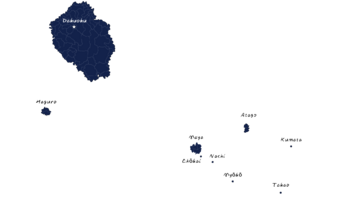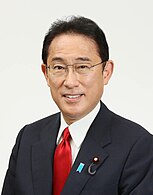Kōri-Chi
Dominion of Kōri-Chi 支配の氷地 | |
|---|---|
 Map of the Dominion of Kōri-Chi | |
| Location | South of Marenesia, North of Antargis |
| Capital | Dākuōku |
| Largest city | Asmotsuki |
| Official languages | Mitonese |
| Ethnic groups | Mitonese, marenesian |
| Demonym(s) | Kōri-Chise |
| Government | Absolute monarchy under a parliamentary democracy |
• Monarch | Emperor Tōhen of Mitō |
• Governor | Sang Aragushi |
| Legislature | Diet |
| Establishment | |
| Population | |
• Estimate | 40,8 millions |
| GDP (nominal) | estimate |
• Total | 220 billions |
• Per capita | 5 400 USD |
| Currency | Imperial Yen |
| Date format | YYY-MM-DD |
| Driving side | left |
| Internet TLD | .em.kc |
This article or section is in the process of an expansion or major restructuring. You are welcome to assist in its construction by editing it as well. If this article or section has not been edited in several days, please remove this template. If you are the editor who added this template and you are actively editing, please be sure to replace this template with {{in use}} during the active editing session. Click on the link for template parameters to use.
This article was last edited by Orioni (talk | contribs) 4 months ago. (Update timer) |
The Dominion of Kōri-Chi, “支配の氷地” in mitonese (pronounced “Shihai no Kōri-Chi”), is a subject state of the Empire of Mitō established in 1923, located in the South Marenesia, very close to Antargis, is an absolute monarchy headed by Emperor Tōhen, who delegated the executive in his name to the office of a Governor elected by an elected parliament. It is renowned for its position on international maritime trade, cheap labour costs alongside fishing industry and temperated to very cold climate.
(1st paragraph. Name. Location. Borders. Approx population and size. Capital city.)
(2nd paragraph. Political system. Short history in 1 sentence. Link with present in 1 sentence. Head of state.)
(3rd paragraph. Economy in 2 sentences. International relations in 1 sentence.)
Etymology
(WIP. Where does your nation's name come from? Most RL national names come from a small variety of choice. Some examples: land of a tribe (ex.France, Persia, Mongolia, Russia), characteristic geography (ex. Netherlands, India, Morocco), an old ruler or religious figure (ex. Philippines, San Marino, Europa, Saudi Arabia), the Latin description of a place (ex. Australia, Argentina, Liberia). How is the name pronounced? How is it translated into other languages?)
Geography
(WIP. Landscape. Climate. Where exactly is your nation compared to others on the global map? Describe the landscape, plants and animals. Which mountains and rivers are important to include? Describe are the climate and seasons? How does geography determine where people live? Are there areas separated from one another? How about cities? This will greatly help you with the next part of history.)
!Siberian/!Antarctic and a bit that would be warm as to allow great population development (Hokkaido versus Tokyo region).[1]
History
(WIP. How did your current nation come to be? What were its previous incarnations? Was it part of a union with a neighbour? Which events shaped the way it is today?)
- Depending on the local population which would originally (or not) inhabit the islands (since like Amsterdam Island, or Reunion Island, there may not be originally any population) because of the region the claim would be situated in.
- $year: Colonised by Mitō in $year (date would depend on how far it is from Mitō, like Australia was colonised late in comparison to Canada)
- 1923: Would ascend to Dominion status in 1923; possibly some “racial” tensions throughout History and still to this day, because of “mitonese superiority”
- The Dominion would take part side by side with Mitō in the WW2 equivalent (and lose, from what I understood?); technologically/economically lagging behind.[1]
Politics
(WIP. Government. Separation of powers. Who rules, how, and for how long? Political parties. What levels of government exist? How about the local level? Who makes the laws? Who deals out your justice? Which government services exist? What is the name of your police? How are the armed forces organised? Foreign affairs, alliances, membership of international organisations.)
Current Governor is Sang Aragushi of the Kaiji Party, which holds 78 of the seats, with its allies the Liberal Party holding 8 seats and the Socialist Party holding 4 seats. Opposition party is the Dentō Party with 79 seats with its ally the Purple-line Party with 2 seats.
Cabinet:
- Current Minister of Home Affairs is Atashita Sogami
- Current Minister of Imperial and Foreign Affairs is Hagana Nosha
- Current Minister of Finance is Erigomo Dontaki
- Current Minister of Justice is Sigo Gounza
Government
The Government is the executive organ of the Dominion, led by the Governor, appointed by the Diet by a simple majority, among its 171 Councilors. The Governor is then presenting his duties to the Emperor, who validates or not his position. The Governor is in charge of appointing Ministers in the name of the Emperor, as to manage the Dominion.
Current Ministries are:
- Ministry of Home Affairs
- Ministry of Imperial and Foreign Affairs
- Ministry of Finance
- Ministry of Justice
- Ministry of Infrastructure
- Ministry of Defense
- Ministry of Navy
- Ministry of Knowledge
- Ministry of Health
- Ministry of Industry
- Ministry of Environment
Diet
The Diet is the legislative organ of the Dominion, composed of 171 Councillors, each elected in their respective prefectures. Councillors may bring matter to the floor of the Diet, that are to be discussed and debated, may result in the drafting of legislations, which are then voted upon, and passing through a simple majority. The Diet have the authority to appoint or dismiss the Governor. The Diet have as authority to create commissions on specific matters (including the governmental actions) as to address and investigate them, before returning to the Diet as to introduce the conclusions, that may lead to further debates and creation of legislation.
Monarchy
The Emperor is the highest figure, disposing of all powers, as an absolute monarch. His regular duties are considered to be accepting the elected Governor or his resignation, alongside the voted decisions of the Diet. He however disposes of a veto power over all legislations passing through the Diet, he may equally force resignation of any Councilor or the Governor, and may pass legislations in force.
Economy
(WIP. Employment. Exports and imports. International partners. Currency. Energy. Transportation. Science & technology. Unemployment numbers. Tourism. Media.)
Demographics
(WIP. Demographics. Ethnic groups. Social classes. Language. Education. Marriage. Religion. Healthcare. Diseases.)
Military
The Imperial Kōri-Chise Armed Forces is composed into 2 branches: the Imperial Kōri-Chise Navy & the Imperial Kōri-Chise Army.
Assets of the Imperial Kōri-Chise Navy are the following:
| Representation | Name | Type | # | List of active assets |
|---|---|---|---|---|
| Example | Shinano-class | Helicopter-carrier amphibious assault ship | 4 | Shinano; Taihō; Unryū; Shōkaku |
| Example | Fusō-class | Destroyer | 12 | Fusō; Yamashiro; Ise; Hyūga; Nagato; Mutsu; Yamato; Musashi; Furutaka; Kako; Aoba; Kinugasa; |
| Example | Kongō-class | Frigate | 20 | Kongō; Takao; Atago; Maya; Chōkai; Myōkō; Nachi; Haguro; Ashigara; Mogami; Mikuma; Suzuya; Kumano; Tama; Chikuma; Tenryū; Tatsuna; Kumata; Kitakami; Nagara |
| Example | Hirado-class | Minesweeper | 6 | Hirado; Chika; Iwao; Chie; Susumu; Kohaku |
| Example | Eiji-class | Patrol | 40 | Eiji; Yoshinaka; Shigeru; Kado; Kyoichi; Takanibu; Kawamura Motoyasu; Haru; Uramoto Hiromu; Kaname; Anri; Shigeri; Nozomi; Tō; Yoshigara; Nezō; Shakā; Gurū; Jinka; Yukisha; Shinzō; Yuzi; Dentoshi; Alakama; Vashi; Masami; Makotobu; Miraira; Makiyo; Lovi; Shentō; Nigōsa; Tenhū; Mōto; Doki; Nenzei; Shirōkama; Mēn |
| Example | Tōshi-class | Supply | 4 | Tōshi; Ninka; Izusho; Zenzē |
| Example | Eirō-class | Icebreaker | 4 | Eirō; Totama; Shunā; Furutoka |
| Example | Nūrashi-class | Submarine | 8 | Nūrashi; Shunza; Nakimō; Matsunama; Noriga; Dokile; Akalo; Kentō |
| Example | Narim-9B | Medium transport helicopter | 80 | 3rd Support Air Transport Squadron; 4th Support Air Transport Squadron |
| Example | Subarashī-4 | Heavy transport helicopter | 40 | 1st Naval Group; 2nd Naval Group; 3rd Naval Group; 4th Naval Group; 1st Navy Light Transport Squadron; 2nd Navy Light Transport Squadron |
| Example | Otogu | Short takeoff and landing amphibious aircraft | 12 | 1st Amphibious Navy Squadron |
| Example | IK-400 | Heavy transport aircraft | 20 | 3rd Navy Transport Squadron; 4th Navy Transport Squadron; 5th Navy Transport Squadron; 6th Navy Transport Squadron |
| Example | Washi-5 | Multi-role fighter | 40 | 8-12th Air Control Squadrons |
Army
Assets of the Imperial Kōri-Chise Army are the following:
| Representation | Name | Type | # | List of active assets |
|---|---|---|---|---|
| Example | L-710 | Armored reconnaissance and tank destroyer vehicle | 20 | — |
| Example | L-610 | Infantry fighting vehicle | 40 | — |
| Example | L-210 | Transport vehicle | 200 | — |
| Example | Narim-9A | Medium transport helicopter | 20 | 1st Support Air Transport Squadron; 2nd Support Air Transport Squadron |
| Example | Subarashī-4 | Heavy transport helicopter | 20 | 1st Light Air Transport Squadron; 2nd Light Air Transport Squadron |
| Example | IK-300 | Heavy transport aircraft | 20 | 1st Air Transport Squadron; 2nd Air Transport Squadron |
| Example | IK-400 | Heavy transport aircraft | 20 | 3rd Air Transport Squadron; 4th Air Transport Squadron |
| Example | Washi-4 | Multi-role fighter | 80 | 1-8th Air Control Squadrons |
| Example | Example | Example | Example | Example |
Cultures
(WIP. Cuisine. Literature. Visual arts. Art. Architecture. Entertainment. Music & Radio. Television. Cuisine. Local customs. Clothing. Morality. Sports. Stereotypes. Your national symbols such as the flag and national anthem. Public holidays and festivities.)
Mitonese (Japanese) and a local culture (depending on where I'll be on the map, will adopt some of the local culture inherent to that part of the map, which would then have Japanese colonists, think of it like NZ who was exclusively Maori, but now because of colonisation have lots of British culture/demographics).[1]
References
- ↑ 1.0 1.1 1.2 Map Application: Dominion of Kōri-Chi (18 January 2022)





